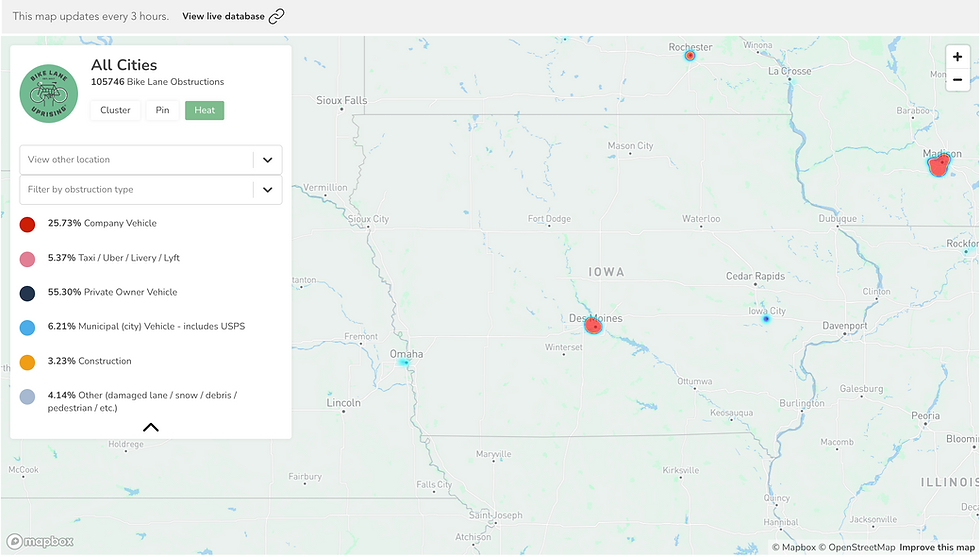CDOT: Chicago Ave Proposed Improvements (Kedzie to Latrobe)
- Bike Lane Uprising

- Sep 1, 2020
- 4 min read
Last week CDOT shared potential improvements for Chicago Ave, via a webinar. Here are some notes from that webinar. (note that these represent one person’s notes on some main ideas. This is not a transcription of the webinar and was not produced in consultation with any of the project planners or webinar organizers.)

More information about the project: here
Direct link to the webinar recording: here
Present on the call:
37th ward alderman Emma Mitts
27th ward alderman Walter Burnett
Representatives from CDOT and Civil Tech Engineering
(28th ward alderman Jason Ervin was not present, although the project does go through the 28th ward.)
Notes from the webinar
The stretch of Chicago Ave. under consideration is from Latrobe (5300 W) to Kedzie (3200 W). The goal of the redesign is primarily to improve safety for all street users (particularly the most vulnerable, including children, the elderly, disabled users, pedestrians, bicyclists, and transit riders). Secondarily, the project aims to complement community economic growth and investment efforts. Currently, the street is an artery for cars to drive through the community, without stopping to patronize local businesses; the planners aim to support local businesses along the route by improving the safety of the street.
Meeting started with brief statements from the two alders
Mitts discussed the importance of Chicago Ave. as a major East-West arterial. She mentioned Invest South/West and existing efforts to enhance the street. She noted that it’s the site of the new cop academy, and mentioned that the project area intersects with SSA #72.
Burnett remarked that the street gives an impression of the communities in that area and that there’s a clear change west of Kedzie. He wants to change the streetscape to reflect a more uplifting vision of the community.
Connections to existing projects & plans
Vision Zero Chicago identified 43 high-crash corridors 2 are along this stretch of Chicago Ave. VZC also identified Humboldt Park and Austin as two of the eight high-crash areas in the city.
Invest South/West - while economic growth isn’t a primary goal of the street redesign, the planners understand that better streets = more economic growth. The planners described Chicago Ave. as the “front door” to the communities it passes through.
A recent IDOT audit determined that Chicago Ave is not safe and warrants change.
The Austin Quality of Life plan highlights Chicago Ave. as an important part of the community.
Funding comes from the Highway Safety Improvement Plan (HSIP)
Problems & Solutions
Please note that the webinar did not present this information in this format or structure - again, this is a summary/overview of issues raised in the presentation, not a transcription of the webinar.

A few statistics
Only 27.4% of drivers drove at or under the speed limit. The extent of speeding makes crashes much more likely to be serious or fatal.
A 2014-2018 study from IDOT found roughly 1500 crashes along this stretch of Chicago, of which 24 involved bicyclists and 101 involved pedestrians. Of the 1500, 49 involved serious injuries and 5 involved deaths. Bike/ped crashes were disproportionately serious.So far in 2020, there have been 300 crashes along this corridor.
Route 66 is one of the CTA’s highest ridership routes.


Potential new cross-sections
In the webinar recording, the presenters begin discussing different street cross-sections at approximately 40:11 - these cross-section designs show different ways that the street space could be repurposed to address the problems noted above. Cross-sections featured various combinations of:
Bike lanes (buffered on one or both sides, or parking-protected)
Bus lanes instead of parking lanes - either as a permanent feature or during certain restricted hours (this would not be compatible with curb bump-outs for pedestrians)
Pedestrian curb extensions into the parking lane (I did not see curb extensions compromising the bike lane in any of the proposed cross-sections - Elizabeth)
Pedestrian islands
Sample proposed improvements



Q&A
Question: What are the safety differences between the various proposed options?
Steve P., project manager: all options are relatively comparable because they include the two most important safety features that provide the largest benefits:
Repurposing street space from 2 lanes with sporadic median to 1 lane with a median throughout
Pedestrian refuge islands.
Question: Why does the project not extend all the way to Austin?
Steve: Chicago Ave. has already been improved west of Laramie.
Dave: the eastern limit was defined by the end of the Vision Zero high-crash corridor.
Question: What information/statistics/data were used to make these plans?
Steve: we used several datasets
Safety/crash data
Traffic count, collected at intersections
Data about CTA route 66 from the CTA
Question: How will the new electric bus rollout affect this?
Dave did not actually answer this question; he just confirmed that the electric busses will run on Chicago Ave. and will be “exciting.”
Question: How will this affect parking? (You knew it was coming!)
As he had already explained in the presentation, Dave reiterated that some options make no significant changes to parking; some restrict parking on one side of the street during rush hour. He repeated that it’s important to design streets for all users, not just drivers. He encouraged feedback.
Question: Does COVID-19 change this plan?
Steve: We’re all still adapting to COVID-19 and not sure how it will affect traffic long-term. We want the street to be flexible and adaptable so it can handle changes. The key is to accommodate everyone so the street can adapt to whatever comes next.
Question: How will this project affect bus frequency?
Dave: The project will include work on signal timing to expedite bus service.
Jason from CTA: frequency is constantly assessed regardless of street redesign. The plan would increase bus reliability but would not specifically affect frequency
Question: how will this plan improve economic development in the area?
Dave: This project is primarily about safety, but safety is critical to economic growth.
Question: why not put the bike lane against the curb?
Dave: That’s present in one of the cross-sections, but it’s only possible in the wider part of the area west of Kostner because parking-protected bike lanes take up more street space.
Planners want feedback
Send comments to info@chicagocompletestreets.org by September 10th
Planners are especially interested in:
Experiences with Chicago Ave. within the project area
Information about people’s preferred modes of transportation on the street
Comments on specific intersections
Comments about parking
Comments about bus travel times and CTA Route 66.












